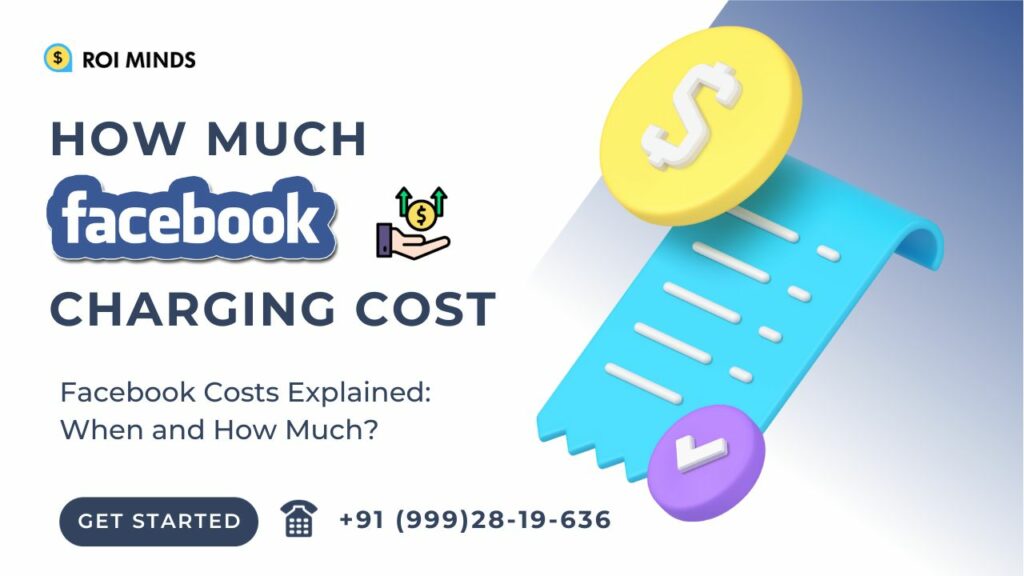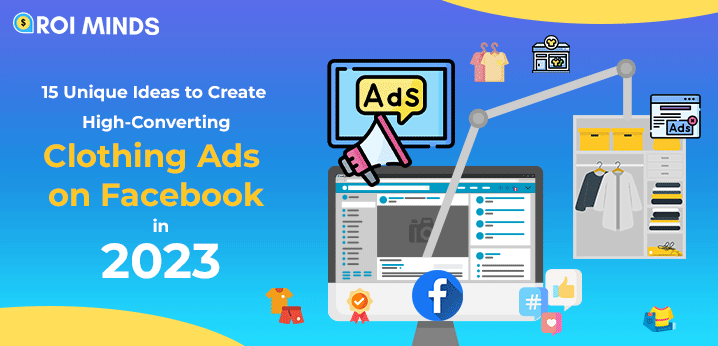Many businesses worldwide use Facebook to put their ads in front of people. About 7 million people are doing this. If you’re a business owner thinking of doing the same, you might wonder, “What’s the price tag for advertising on Facebook? How much do they charge?”
This blog will discuss all about Facebook Advertising Cost, from what the term means to how we can, as the best agency, help you with Facebook Advertising.
History And Evolution of Facebook Charging Fees
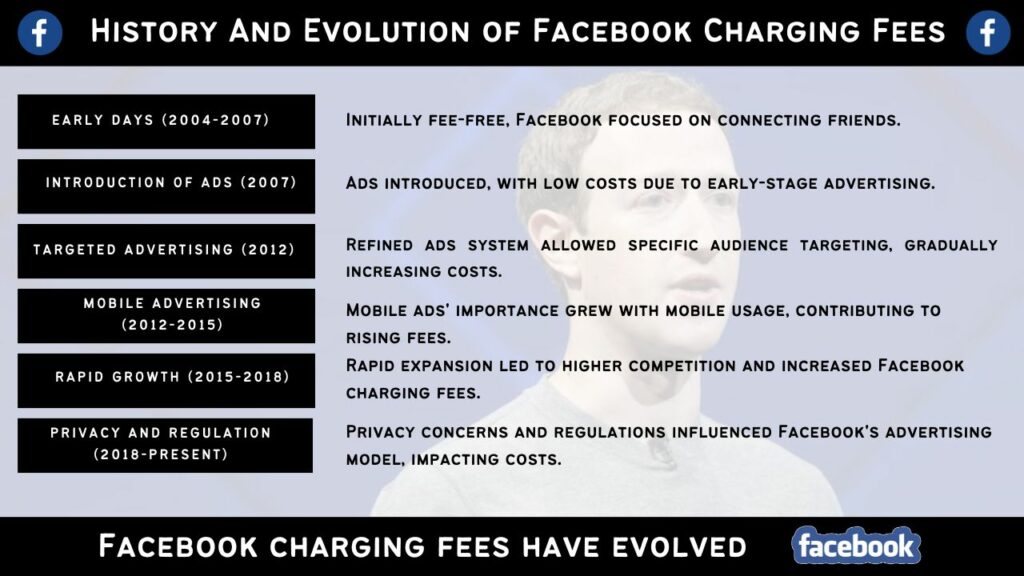
Facebook charging fees have evolved, transitioning from its early days without fees to becoming a significant revenue stream for the company.
- Early Days (2004-2007): Facebook initially started without any advertising fees as it focused on connecting friends.
- Introduction of Ads (2007): In 2007, Facebook introduced ads, but the Facebook advertising cost was relatively low because the platform was still in its early stages of advertising.
- Targeted Advertising (2012): Around 2012, Facebook began to refine its advertising system, allowing businesses to reach specific audiences, gradually increasing its advertising cost.
- Mobile Advertising (2012-2015): As mobile usage grew, so did the importance of mobile ads on Facebook. Businesses saw the potential in reaching users on their phones, contributing to the rise in advertising fees.
- Rapid Growth (2015-2018): Facebook’s advertising platform expanded rapidly during this period, leading to increased competition and higher Facebook charging fees.
- Privacy and Regulation (2018-Present): Recently, concerns about user privacy and government regulations have influenced Facebook’s advertising model. While advertising on Facebook remains widespread, businesses must navigate new rules, impacting Facebook ad costs.
Understanding The Facebook Business Model
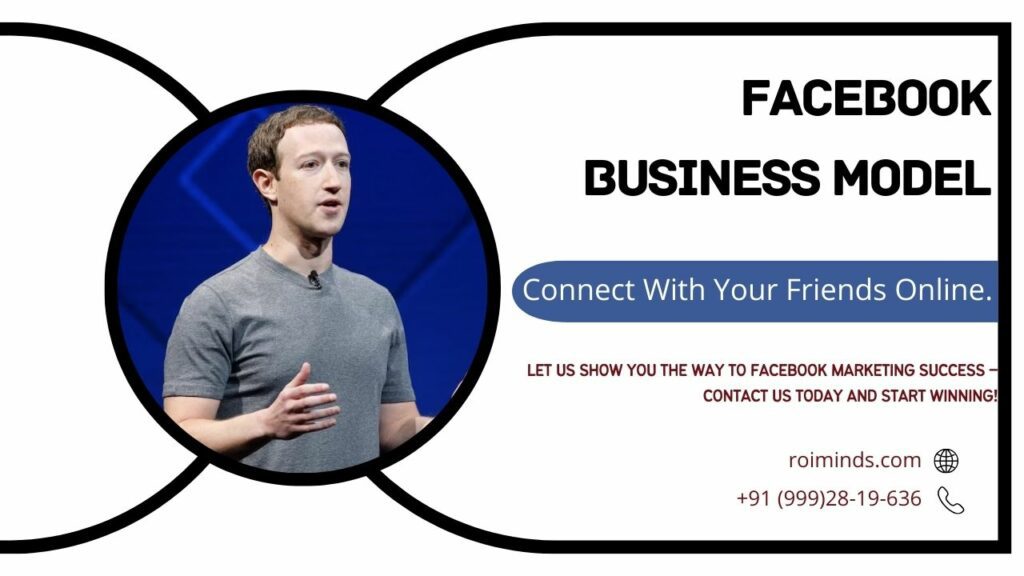
Think of Facebook as a global hangout spot. It’s free to chat with friends and share stuff. But, Facebook makes its money from businesses that pay to show ads to its 2 billion users. They collect data to make ads super specific.
So, about Facebook charging fees for ads – it’s not one price for all. The cost varies based on who you want to reach, competition, and ad quality. But relax, they have tools to manage costs. You set a budget, and Facebook’s smart tech makes sure you get the best results.
Factors Facebook Considers Before Setting Price
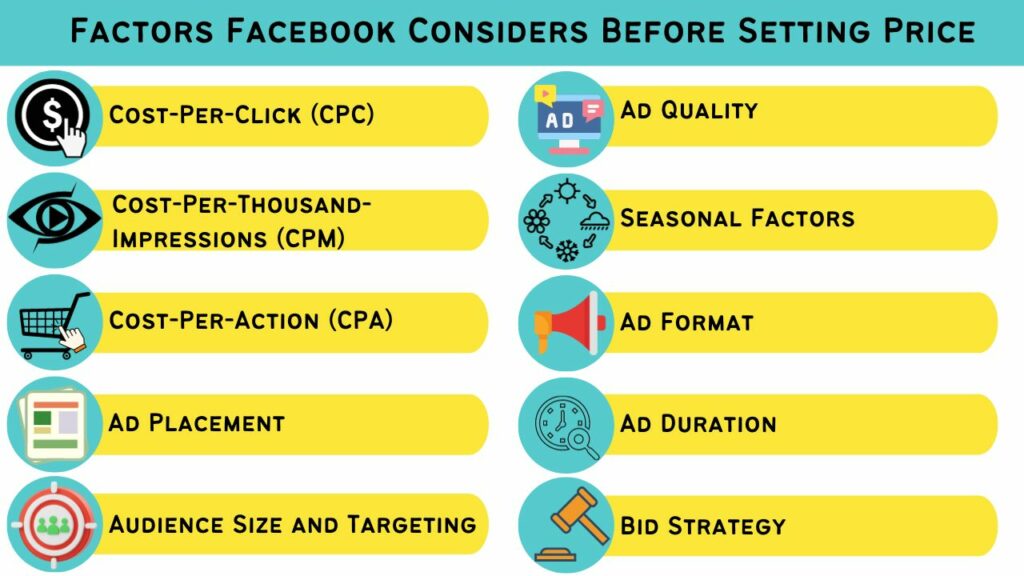
In 2024, Facebook advertising costs can vary widely depending on various factors, including your target audience, ad quality, and competition. Here’s an overview of typical costs associated with Facebook Advertising:
Cost-Per-Click (CPC):
It is one of the most common pricing models on Facebook. The average CPC can range from $0.584 to $2 or more, depending on your industry and ad quality.
Cost-Per-Thousand-Impressions (CPM):
CPM is another pricing model where you pay for every 1,000 times your ad is shown, regardless of clicks. In 2024, the average CPM can range from $10 to $11, with some industries having higher costs.
Cost-Per-Action (CPA):
You pay for a specific action in CPA advertising, like a form submission or app download. Costs vary widely based on the activity you want users to take, but they range from $5.47 to $19.68.
Ad Placement:
Where your ads appear on Facebook affects costs. In-feed ads cost less than those placed in Instagram Stories or the Facebook Audience Network.
Audience Size and Targeting:
The broader your target audience, the lower the Facebook advertising cost. However, highly targeted audiences often have higher prices because they’re in high demand.
Ad Quality:
Well-designed and engaging ads tend to have lower costs because Facebook rewards relevance. High-quality ads often receive more impressions at a lower price.
Seasonal Factors:
Costs can fluctuate during holidays or peak shopping seasons when competition is high.
Ad Format:
Different ad formats have additional costs. Video ads, for instance, may cost more to produce but can be very effective.
Ad Duration:
Longer-running ads may have higher cumulative costs but can lead to better results.
Bid Strategy:
Facebook offers automatic and manual bidding options. Manual bidding allows you to control costs more precisely but requires careful management.
Detailed Analysis Facebook Advertising Statistics (Source: Sprout Social and Hootsuite)
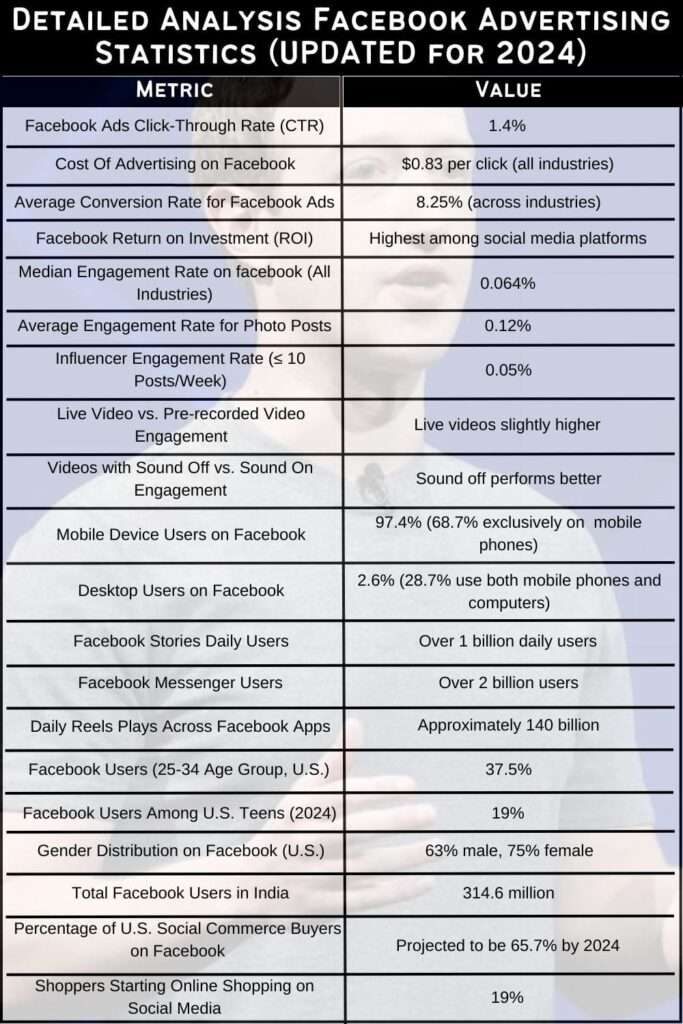
Is Facebook advertising still valuable for your business? Let’s explore some eye-opening Facebook advertising statistics to understand its impact on the platform.
- According to a study by WordStream, the average Facebook ad click-through rate (CTR) is 1.4%.
- The cost of advertising on Facebook is $0.83 per click across all industries, especially in specific sectors like finance, insurance, and customer service.
- Facebook boasts a relatively high average conversion rate of 8.25% for ads across industries.
- Facebook Yields the Highest Return on Investment (ROI) compared to other social media platforms.
Facebook Engagement Statistics
- A study reveals that brands achieve a median engagement rate of 0.064% across all industries on Facebook.
- Visual content remains king on Facebook, with photo posts leading the pack at an average engagement rate of 0.12%.
- It is followed by status, video, and link posts at 0.11%, 0.08%, and 0.03%, respectively.
- The RivalIQ study highlights that influencers who post fewer than ten times a week outperform media companies with an average engagement rate of only 0.05%.
Facebook Video Statistics
- Live videos enjoy significantly higher engagement rates than pre-recorded ones but for accounts with at least 50,000 fans, pre-recorded videos slightly outperform live ones.
- ChatterBlast Media’s findings indicate that videos with sound off perform better than those with sound on.
Facebook Device Statistics
- Nearly all Facebook users (97.4%) access the platform through mobile devices, with 68.7% exclusively using mobile phones.
- In contrast, only 2.6% of users rely solely on laptops and desktops to access Facebook, with 28.7% using mobile phones and computers.
Facebook Feature Stats (Reels, Stories, Messenger)
- Internal Facebook data reveals that over 1 billion people use Facebook Stories daily. This popularity makes it a valuable tool for brands looking to engage their audience.
- Facebook Messenger boasts over 2 billion users, presenting a vast potential audience for your Messenger ads.
- Reels continue to thrive, accounting for approximately 3.3% of impressions across the Facebook family of apps.
Facebook Audience and Demographics Statistics
- Despite its reputation as an older network, 37.5% of Facebook users in the United States fall within the 25-34 age group.
- Facebook’s popularity among teenagers has significantly declined, with only 19% of teens using the platform as of 2024, marking a sharp drop from the 71% usage reported between 2014 and 2015.
- Based on available data, Facebook has more female users (75%) than male users (63%).
- While Facebook enjoys widespread usage across various countries, India claims the most extensive user base, with 314.6 million users.
Facebook Consumer Behavior Statistics
- Facebook has the highest number of social commerce buyers, and by 2024, it’s projected that 65.7% of U.S. social commerce buyers will be on Facebook.
- The report highlights that 19% of U.S. consumers start their online shopping journey by searching on social media.
Despite evolving trends and changing demographics, Facebook remains a potent platform for advertising and engaging with your target audience. Understanding these statistics can help you fine-tune your Facebook advertising strategy for optimal results.
Future Of Facebook Charging Fees
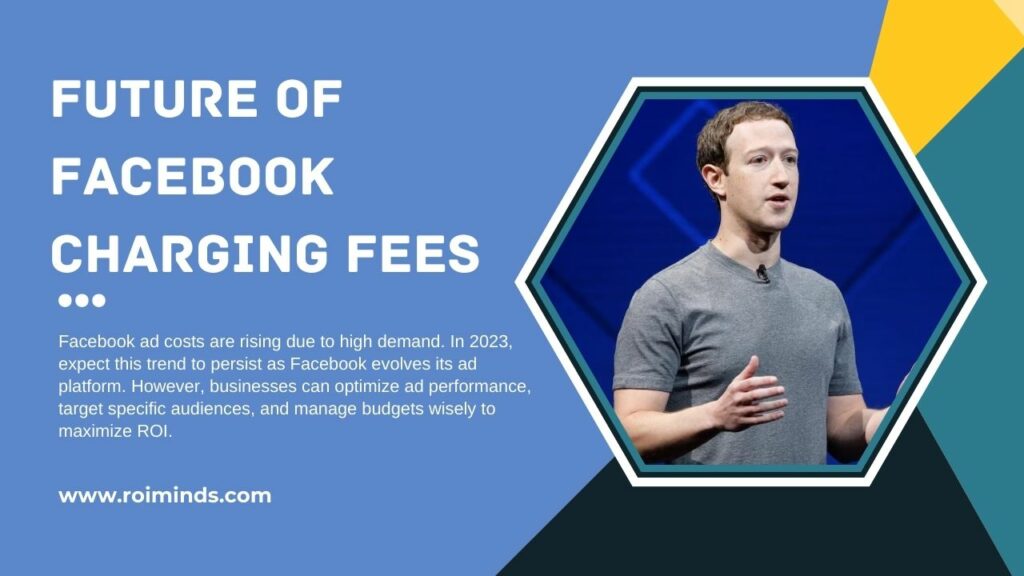
Facebook is a massive place for ads; many businesses want to show their stuff there. Because of this, the cost of putting your ads on Facebook has been increasing. In 2024, this trend will continue. Facebook keeps changing how ads work, which can make them pricier.
But don’t worry, there are ways to deal with this. Businesses can make their ads work better by ensuring more people who see them do what the company wants, like buying something. They can also be smart about how they spend their ad budget and aim their ads at specific groups of people. So, while Facebook charges fees for ads, there are strategies to make it work effectively for your business.
How ROI Minds Can Help With Facebook Charging Fees
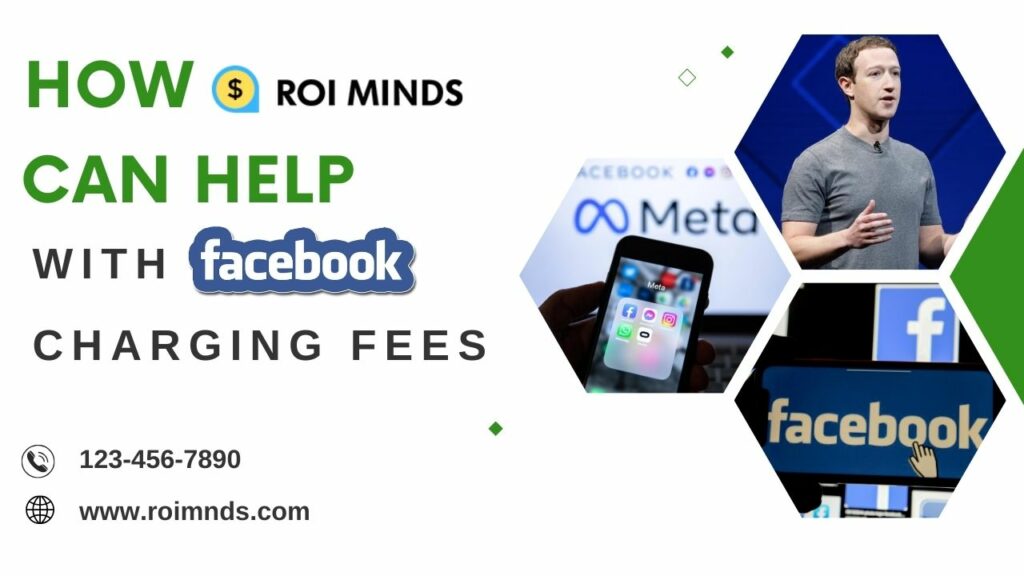
Hey there! 🚀 Ever wondered how to tackle those rising Facebook fees? Look no further! 😊
At ROI Minds, we’ve got your back. 💪 Our mission is to help you make every dollar spent on Facebook ads count. 💰
📈 Worried about those increasing Facebook advertising costs? Don’t be! We’re experts at optimizing your ad account to get the best bang for your buck. 🎯
💡 Here’s how we roll: We team up with your brand to set up a smart ad budget, ensuring you get the most out of your advertising money. 💸 Then, we take charge of your ad account, fine-tuning it for supercharged results. 🚀
💼 We’re not just managing ad spending; we’re your financial wizards in the Facebook advertising universe! We ensure your investments yield the best possible returns. 🌟
So, if you’re worried about Facebook charging fees and rising advertising costs, let ROI Minds be your guiding star! 🌠
Ready to make your ad spend work wonders? Let’s chat! 😉✨
Conclusion
In conclusion, understanding the truth about Facebook charging fees in 2024 is paramount as we navigate the ever-evolving digital advertising landscape. The reality is that Facebook ad costs are subject to numerous factors, from ad quality to audience targeting and beyond.
While the costs may fluctuate, the power of Facebook as an advertising platform remains undeniable. It’s a dynamic space where innovation and data-driven decision-making can mitigate the impact of rising Facebook advertising costs. By staying informed, optimizing campaigns, and embracing the full potential of this platform, businesses can continue to harness its vast reach and potential for growth.

